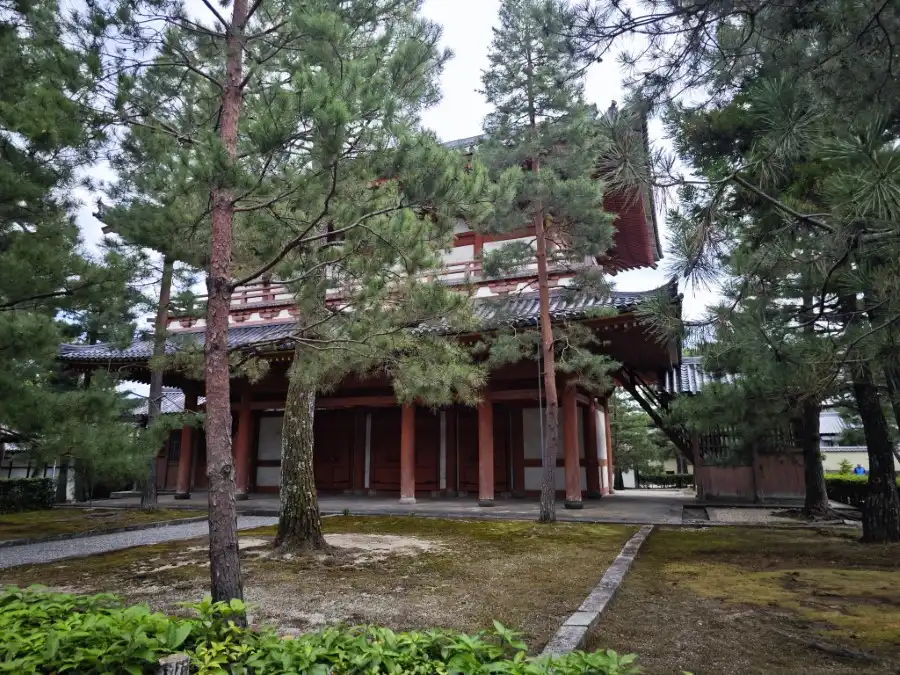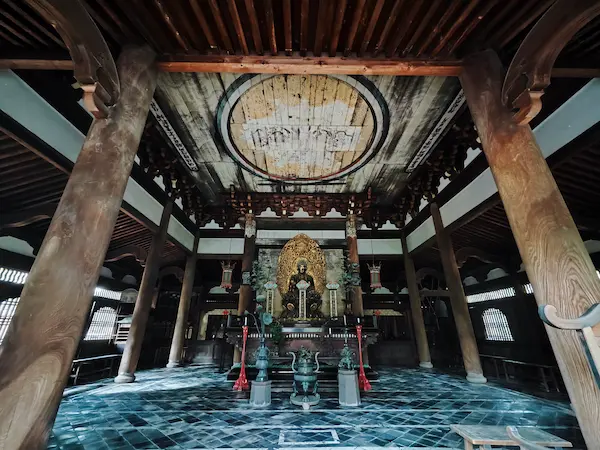The best time to visit Daitokuji is in the fall. Many sub-temples are open to the public in this season.
History of Daitokuji Temple
Daitokuji Temple is the head temple of the Daitokuji School of the Rinzai sect of Zen Buddhism. It was founded in 1315 at the end of the Kamakura period.
Onin War devastated the Temple. But monk Ikkyu restored it. In 1583 (Momoyama period), Toyotomi Hideyoshi built Soken-in sub-Temple, to mourn the loss of Oda Nobunaga. And then, the temple prospered as many Daimyo (warlords) competed to build sub-temples.
The Temple has a temple complex that includes a gate, a Buddha hall, a main hall, a hojo, a kuri (kitchen), a monastery, a bathhouse, a sutra library, and a bell tower. Many of these are designated as Important Cultural Properties or National Treasure.
Sanmon gate has another name “Golden-feather Pavilion (Kinmokaku)” . In 1589, Sen no Rikyu added a second floor to the gate. So the temple was so grateful that it enshrined Sen no Rikyu’s wooden statue on the second floor of Kinmokaku. This angered Toyotomi Hideyoshi, the powerful ruler of the time. And it was one of the reasons Sen no Rikyu committed seppuku (ritual suicide).

The temple precincts retain the atmosphere of a Zen temple from the Edo period.
The inside of the Temple is usually not open to the public. However, on rare occasions, some of them may accept public at events.



Daitokuji sub-temples
There are two annexes and 22 sub-temples. Sub-temples include Soken-in, Daisen-in, Hoshun-in, Korin-in, Zuiho-in, Ryogen-in, and Obai-in among others.
Some sub-temples are open to the public throughout the year. Some are open on special occasions. Others are always not open to the public.
Soken-in Temple
In the main hall of Soken-in there is a wooden seated statue of Oda Nobunaga (Important Cultural Property) dedicated by Hideyoshi.
Daisen-in Temple
Daisen-in is the most important sub-temple. It is open to the public.
Hoshun-in Temple
Hoshun-in Temple has a bonsai garden. This garden is open to the public for a fee. It is not to be missed by anyone interested in bonsai.
Korin-in Temple
Korin-in is open on special occasions in spring and autumn.
Zuiho-in Temple
Zuiho-in has the famous “cross garden”.
Ryogen-in Temple
Ryogen-in has three dry landscape gardens. The original buildings, the Hojo, Karamon, and Omotemon, are important cultural properties.
Obai-in Temple
The gardens in Obai-in temple are must see if you have chance. Obai-in is only open to the public during limited times of the year.
Nearby spots from Daitokuji Temple
Imamiya Jinja Shrine is located just north of Daitokuji Temple.
Related articles:
[…] is the sub-temple of Daitokuji Temple. It is not open to the public except on special viewing days. It was built in the 1520s by the […]
[…] was finalized by Ashikaga Yoshimitsu in the Muromachi period (1336-1573), but Myoshinji Temple, Daitokuji Temple, and other large temples of the same Rinzai sect opposed the temple ranking and were said to be at […]
[…] is a sub-temple of Daitokuji Temple. This temple is usually open to the […]
[…] is a sub-temple of Daitokuji Temple. This temple was founded in 1502 by Yoshimoto Hatakeyama, Yoshinaga Otomo, and Yoshioki Ouchi. It […]
[…] Daisen-in is the most important sub-temple of Daitokuji Temple. […]
[…] Daitokuji Temple has a large complex with several buildings. Many of these are Important Cultural Properties or National Treasures. […]
[…] Myoshinji Temple has a long and rich history. Emperor Hanazono invited the priest Kanzan Egen from Daitokuji Temple. Egen sought to create a place for the practice and dissemination of Zen […]
[…] in 1562 as a memorial service for his father, Oda Nobuhide. And it is one of the sub-temples of Daitokuji Temple. After Nobunaga’s sudden death due to the Honnoji Incident, Hideyoshi Hashiba (later […]
[…] temple is a sub-temple of Daitokuji Temple, and located within its […]
[…] temple is a sub-temple of the Daitokuji Temple. This temple is located at the northernmost point of the Daitokuji temple compound. It is located […]
[…] Unrin-in Temple has only a small hall on the opposite side of the road from Daitokuji Temple and is virtually unvisited. However, this site is an important historical site in Murasakino Area […]
[…] precincts of Unrin-in Temple. Today, Unrin-in is only a small hall and is one of the sub-temples of Daitokuji Temple. But it was a large and important temple in the Heian […]